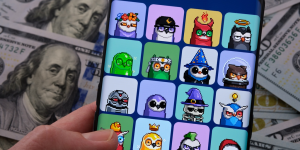NFT skis, Bitcoin bobsledders and CBDC controversy

The 2022 Winter Olympics, officially called the XXIV Olympic Winter Games, kicked off on Feb. 4 in Beijing with crypto being a major part of the event, partly because of the Chinese government’s digital currency ambitions.
The cryptocurrency community hasn’t had strong ties to the Olympics over the last few years. The last major headline-grabbing interaction was when the Dogecoin (DOGE) community helped fund the Jamaican bobsled team in 2014 so they could attend the event in Sochi.
The 2022 Winter Olympics, however, are making history due to the presence of nonfungible tokens (NFTs), Bitcoin- (BTC)-supported athletes, the launch of the world’s first major central bank digital currency (CBDC) and their potential use as a payment method in a country that has effectively banned cryptocurrency trading and mining last year.
China’s digital yuan controversy
The 2022 Winter Olympics were supposed to be a sort of coming-out party for the digital yuan, China’s CBDC. The People’s Bank of China, China’s central bank, has been trialing the digital yuan in several areas for years now and started allowing foreigners to use the digital currency for the first time during the event.
The digital currency can be used through the government’s mobile app, e-CNY, or through mobile payments platforms developed by private sectors including Tencent Holdings’ WeChat, China’s messaging application with over one billion users.
The app’s launch was reportedly stymied by COVID-19 restrictions that saw athletes, officials and journalists be largely separated from the rest of China in a quarantine “bubble” meant to prevent the spread of various strains of COVID. This bubble, combined with the government limiting the number of in-person spectators, has seemingly seen the number of people testing the digital yuan drop significantly.
However, other reports suggested that more transactions were made using the digital yuan on the day of the opening ceremony than through Visa.
Transactions using the digital yuan have totaled more than $13 billion since its launch with roughly 10 million merchants activating digital wallets by November 2021. That figure is dwarfed by Visa’s $12.5 trillion volume for the 12 months ending June 30, 2021.
Speaking to Cointelegraph, Fergus Hodgson, director of financial consultancy firm Econ Americas, said that the Olympics have “have become a marketing opportunity for governments, usually one that loses money,” and added:
“A digital yuan is just another fiat currency that deserves to be outcompeted by private currencies or at least sovereign currencies not built on the backs of slave labor and totalitarianism.”
The perceived threat of a digital yuan on dollar hegemony has seen United States Secretary of State Antony Blinken and Treasury Secretary Janet Yellen warn against the digital yuan’s rollout at the Olympics, as it could supposedly threaten U.S. interests. In July, a group of three senators sent a letter to the U.S. Olympic and Paralympic Committee claiming that the Chinese Communist Party could use the CBDC to surveil visiting athletes.
China’s digital currency is expected to give the country’s government new tools to monitor its economy and control a larger share of the global digital economy.
David McCarville, director at law firm Fennemore, seemingly agreed, telling Cointelegraph that Chinese authorities have “cracked down on the crypto industry as a threat to their natural security,” as “the decentralized nature of crypto assets” undermines the Chinese government and its need to “censor data and monitor financial transactions for economic surveillance purposes.”
McCarville noted that there is “evidence that the Chinese authorities are intent on using the digital yuan to expand their economic surveillance activities,” adding:
“By utilizing the digital yuan, a user is susceptible to ongoing surveillance in addition to potential malware and virus exposure. Without a clear understanding of the closed source coding used to create the digital yuan, it is almost impossible to make an informed decision.”
To Eli Taranto, chief business development officer at digital bank EQIBank, China’s crypto crackdowns may not be related to its CBDC. He told Cointelegraph:
“Crypto represents a sort of grassroot revolution that is changing some balances that were in place until recently. Clearly, not everyone is in favor of these kinds of transformations but, in the long run, they won’t be able to stop them no matter how hard they try.”
NFTs at the Olympics
While China’s CBDC has been making headlines, nonfungible tokens have been used to captivate fans and art lovers.
Several NFT projects have been launched to engage with fans at the Olympics. One of the more significant initiatives came from the International Olympic Committee (IOC), which collaborated with NFT marketplace and game studio nWayPlay to launch the Olympic Heritage Collection of Olympic NFT pins.
These Olympic NFT pins are essentially digital versions of physical collectible and tradable pins that celebrate the past Olympic Games through posters, emblems, pictograms and mascots from the last 125 years.
On top of that, the IOC released a play-to-earn (P2E) multiplayer video game developed by nWay called Olympic Games Jam: Beijing 2022. The game lets players compete in a series of Winter sports to earn Olympic NFT digital pins.
These NFTs can be traded on the nWayPlay marketplace and boost players’ power-ups, grant them special avatar skins and sporting equipment. The app is notably not available in China where the Olympic games are being held.
The British Olympic Association that represents Great Britain and Northern Ireland, Team GB, has also moved into the NFT space through the so-called Gold Lion Club NFT community. The project is meant to engage fans and was launched in partnership with commerce provider Tokns.
Purchasing Gold Lion Tokns allows fans to gain access to signed merchandise, athlete experiences and an upcoming immersive clubhouse in the Metaverse.
Moreover, Chinese tech giant Alibaba has launched four NFTs called “digital collectibles,” featuring sports at the Winter Olympics. These NFTs will feature traditional Chinese ink painting style and depict speed skating, aerial freestyle skiing, figure skating and slopestyle.
Alibaba’s NFTs are available on its Tabao and Tmall marketplaces during the course of the Beijing 2022 Winter Olympics. Given the Chinese government’s stance on the subject, Alibaba has made it clear owners of these NFTs are “barred from using the digital collectibles for any commercial purpose.”
Taranto told Cointelegraph that NFTs are a “great way to manage sentiment and build long lasting loyalty” and added a Chinese proverb to offer insight into digital assets’ current status in China: “Good Medicine Always Tastes Bitter,” which encourages short-term sacrifices for long-term gains.
To Taranto, NFTs are “no different” and crypto assets “will be allowed in China and this ban is probably temporary:” The rules, he said, are likely going to be relaxed “as soon as CBDC testing is complete and nationwide adoption is a virtual certainty.”
US bobsledder’s orange pill
Olympic bobsledder Johnny Quinn was the latest sports star to swallow the orange pill and become a Bitcoin proponent. On social media, Quinn shared resources that could help his fans learn more about the flagship cryptocurrency and warned them they should “under no circumstance” take orders from “the mainstream” as “they are confused.”
As a Class of 2021 #Bitcoin-er, I would like to unofficially-officially welcome the Class of 2022. Buckle up for a legacy impacting journey. First things first: it is critical that you to develop a proper framework regarding #BTC. Attached is your required reading list. Thread
— U.S. Olympian Johnny Quinn (@JohnnyQuinnUSA) February 2, 2022
The athlete told his fans to “start small” and take their time reading and understanding Bitcoin as money, as a payments network and as a store of value. He backed his comments with a barrage of media reports showing how large institutional players — including JPMorgan and Goldman Sachs — made a U-turn on BTC with time.
Quinn suggested that applying a dollar-cost averaging strategy to a Bitcoin investment with a long time horizon is the best strategy for those interested in gaining exposure to it. The American bobsledder joined other sports stars in promoting the cryptocurrency, with some even taking their annual salaries in BTC.
He is notably not the first Olympian to support cryptocurrencies. Cameron and Tyler Winklevoss, the founders of the Gemini cryptocurrency exchange, were both Olympic rowers.
The United States’ national governing body for the sport of figure skating, U.S. Figure Skating, also enabled donations in cryptocurrencies like Bitcoin after partnering with donations platform Engiven.
Taranto applauded that crypto and blockchain products “have taken center stage and are a part of the global debate” during the Olympics and predicted that:
“Whether it’s NFTs, Bitcoin or DeFi today — it is only a matter of time until the Olympics take place in the Metaverse tomorrow.”
Crypto’s growing presence at events like the 2022 Winter Olympics shows the space’s influence is growing, so much so that it’s becoming impossible to ignore. With companies like FTX, Coinbase and Crypto.com advertising during the Super Bowl and new partnerships with sports clubs filled with fans, crypto awareness may explode this year.













